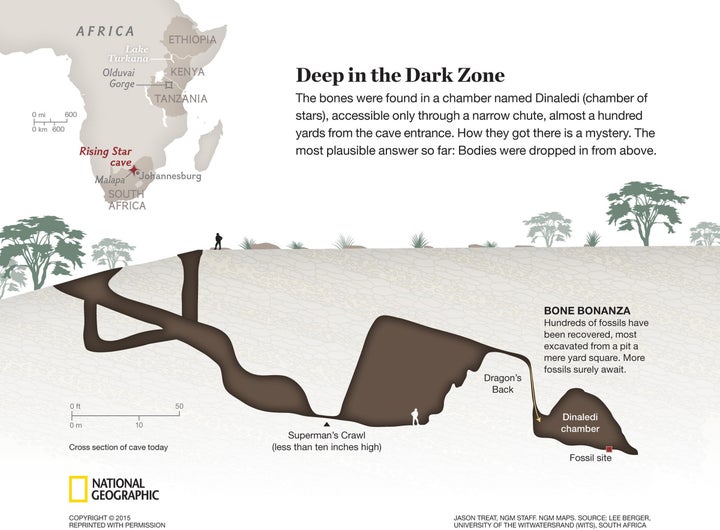Fossils belonging to a previously unknown species of human relative have been discovered in a cave system northwest of Johannesburg, South Africa, an international team of scientists announced Thursday.
The discovery of Homo naledi is expected to shed new light on the human family tree, according to a written statement released by the National Geographic Society, the University of Witwatersrand, and the South African Department of Science and Technology.
What's more, the fossils seem to indicate that H. naledi deposited the bodies of its dead in a remote part of the cave -- a behavior previously believed to have been practiced only by humans. In all, an astonishing 1,550 fossils belonging H. naledi were found in the Rising Star cave system.
"There are over 1,500 hominin fossils and not a single other fossil from a large African mammal. That was the first indication that this locality was unusual and the absence of other fossils is an important piece of evidence that this accumulation of bodies was deliberate," Jeremy DeSilva, an associate professor of anthropology at Dartmouth College in New Hampshire and a co-author of a paper describing the new species, told The Huffington Post in an email. "It was stunning, and an absolute thrill, to work with such a large collection of hominin fossils."
(Story continues below images.)

A cross-section showing the chamber within the Rising Star cave near Johannesburg, where the fossils of a new species, Homo naledi, were discovered.

Lee Berger's daughter, Megan, acting as a safety caver on the expedition, and underground exploration team member Rick Hunter navigate the narrow chutes in the Rising Star cave in South Africa.
The fossils were unearthed in two expeditions conducted in November 2013 and March 2014. Since then, they have been cleaned, examined and analyzed by more than 50 scientists and researchers.
The researchers concluded that the fossilized bones belonged to at least 15 females, males and children who may have all been entombed at the same time at the site.

A composite skeleton of H. naledi, surrounded by some of the hundreds of other fossil elements recovered in the Rising Star cave in South Africa.
According to the researchers, an adult H. naledi probably had long legs, stood about 5 feet tall, weighed 100 pounds, and had ape-like shoulders as well as hands with peculiar fingers.
"The hands suggest tool-using capabilities," Dr. Tracy Kivell, a biological anthropologist at the University of Kent in England, who was part of the team that studied H. naledi’s anatomy, said in a press release. "Surprisingly, H. naledi has extremely curved fingers, more curved than almost any other species of early hominin, which clearly demonstrates climbing capabilities."
Meanwhile, the feet of H. naledi may have been "virtually indistinguishable from those of modern humans," William Harcourt-Smith, assistant professor of anthropology at City University of New York's Lehman College, said in the same release. Harcourt-Smith led the study of H. naledi's feet.
The species also likely had a tiny brain and skull -- smaller than a modern human's.

The braincase of a composite male skull of H. naledi that measures about 560 cubic centimeters in volume -- less than half that of the modern human skull pictured behind it.
What do other scientists make of the discovery? Some were wowed by the news, but others were dubious that the fossils represent a new species, The Associated Press reported.
"From what is presented here, [the fossils] belong to a primitive Homo erectus, a species named in the 1800s," Tim White, professor of integrative biology at the University of California, Berkeley, told the AP.
The researchers noted that more H. naledi fossils may be waiting to be discovered inside the cave -- and they are continuing to study the fossils that have been recovered.
For instance, further analyses of the teeth may provide insight into the species' growth, development and diet. As DeSilva said, "This is just the start."
The new research was published online Thursday in the journal eLife.
